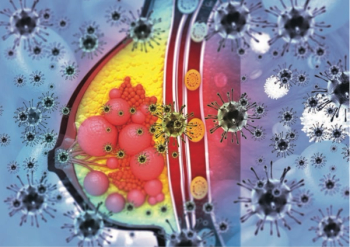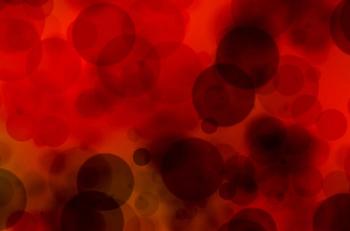
Robust Responses Occur With UGN-102 in Recurrent Intermediate-Risk NMIBC
Data from the ENVISION trial may support UGN-102 as a well-tolerated, efficacious treatment in non–muscle-invasive bladder cancer.
Patients with low-grade, recurrent, intermediate-risk non–muscle-invasive bladder cancer (NMIBC) experienced enduring responses following treatment with the intravesical mitomycin solution UGN-102, according to findings from the phase 3 ENVISION trial (NCT05243550) presented in a poster session at the
Findings showed that of the 240 patients enrolled, the complete response (CR) rate at 3 months with UGN-102 was 79.6% (95% CI, 73.9%-84.5%); the estimated 18-month duration of response (DOR) rate after achieving CR at 3 months was 80.6% (95% CI, 74.0%-85.7%). Twenty percent of patients had a non-CR, which comprised residual disease (15%), disease progression (2.9%), indeterminate response (0.83%), and missing data (2.1%).
“These observations provide further evidence that UGN-102 may represent a well-tolerated and efficacious treatment option for patients with low-grade, intermediate-risk NMIBC,” lead study author Sandip Prasad, MD, a minimally invasive urologic oncologic surgeon of Morristown Medical Center/Atlantic Health System and Garden State Urology in Morristown, New Jersey, and coinvestigators wrote in a poster presented during the meeting. “UGN-102 would potentially be the first approved medical therapy for this condition.”
The data readout follows the FDA’s Oncologic Drugs Advisory Committee
The committee had discussed whether randomized studies should be required in the future to assess treatment efficacy in this specific NMIBC setting, and whether the overall risk/benefit profile of UGN-102 was favorable for these patients, specifically those with recurrent disease.
Standard therapy for patients with low-grade, intermediate-risk NMIBC is transurethral resection of bladder tumor (TURBT). UGN-102 is a reverse thermal gel containing mitomycin given via intravesical instillation in the outpatient setting and has shown effectiveness at replacing surgery in prior data.3,4
In the ongoing, prospective, international, single-arm, open-label phase 3 ENVISION trial, investigators tested the efficacy and safety of UGN-102 as treatment for patients with recurrent low-grade, intermediate-risk NMIBC. UGN-102 was administered as 6 once-weekly intravesical instillations (75 mg of mitomycin) in an outpatient setting.1
To be eligible for enrollment, patients must have had history of at least 1 prior episode of low-grade NMIBC that required treatment with TURBT, disease that was confirmed by cystoscopy and cold-cup biopsy at screening or within 8 weeks prior to screening, negative voiding cytology for high-grade disease, and intermediate-risk disease, which was defined as having 1 or 2, not all, of the following: multiple tumors, longest tumor diameter larger than 3 cm, and/or early or frequent recurrence. Intravesical chemotherapy, except for a single dose immediately after prior TURBT within the past 2 years, was not permitted.
The primary end point was 3-month CR; secondary end points were DOR and safety.
Patients who achieved a CR at 3 months entered the follow-up period, of which they will return to clinic every 3 months for up to 2 years for response evaluation. Those who remain disease free will continue to return to clinic every 6 months for up to another 3 years, totaling 5 years of follow-up.
If patients did not achieve a CR at 3 months, they were given investigator-chosen standard therapy and then entered the follow-up phase.
Data presented at the 2025 ASCO Annual Meeting included that from an analysis with a data cutoff date of October 2, 2024, which provided 18 months of follow-up after 3-month CR. All enrolled patients (n = 240) received at least 1 dose of UGN-102 and 95% of patients received all 6 weekly doses.
Baseline characteristics showed that mean age was 68.8 years (standard deviation, 12) and 61% of patients were male; most were White (98%). Pre-biopsy, most patients had a tumor diameter within 3 cm (92%) and aggregate tumor burden also within 3 cm (81%). Eighty-three percent of patients had multiple tumor counts.
Further findings showed that, over a median follow-up of 18.7 months, the median DOR was not estimable due to the paucity of disease recurrence.
Regarding safety, adverse effects (AEs) were generally mild to moderate in severity and resolved. Treatment-emergent AEs occurred in 57% of patients, the most common of which being dysuria (23%), hematuria (8.3%), urinary tract infection (7.1%), pollakiuria (6.7%), fatigue (5.4%), and urinary retention (5.0%). Serious AEs occurred in 12% of patients, 2 of which were found to be related to treatment (urinary retention and urethral stenosis).
Three grade 4 AEs were reported but were unrelated to UGN-102: metastatic lung cancer, a cerebrovascular event, and pancreatic adenocarcinoma. Three deaths occurred and were not treatment related, consisting of a cardiac event, pneumonia, and unknown cause.
References
- Prasad SM, Mihaylov NV, Khuskivadze A, et al. Duration of response (DoR) following treatment with UGN-102 in patients with recurrent, low-grade, intermediate-risk, non-muscle invasive, bladder cancer: 18-month DoR data from the phase 3 ENVISION trial. J Clin Oncol. 2025;43(suppl 16):4598. doi:10.1200/JCO.2025.43.16_suppl.4598
- FDA. May 21, 2025 meeting of the Oncologic Drugs Advisory Committee (ODAC). YouTube. Accessed June 6, 2025. https://www.youtube.com/live/5ecyDbK9ezc
- Prasad SM, Huang WC, Shore ND, et al. Treatment of low-grade intermediate-risk nonmuscle-invasive bladder cancer with UGN-102 ± transurethral resection of bladder tumor compared to transurethral resection of bladder tumor monotherapy: a randomized, controlled, phase 3 trial (ATLAS). J Urol. 2023;210(4):619-629. doi:10.1097/JU.0000000000003645
- Prasad SM, Shishkov D, Mihaylov NV, et al. Primary chemoablation of recurrent low-grade intermediate-risk nonmuscle-invasive bladder cancer with UGN-102: a single-arm, open-label, phase 3 trial (ENVISION). J Urol. 2025;213(2):205-216. doi:10.1097/JU.0000000000004296
Newsletter
Stay up to date on recent advances in the multidisciplinary approach to cancer.

















































































